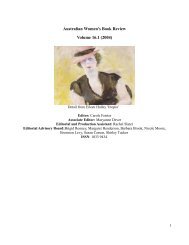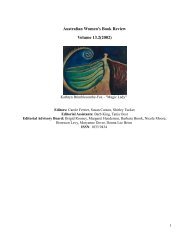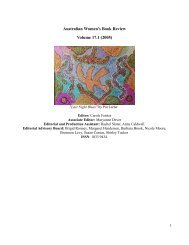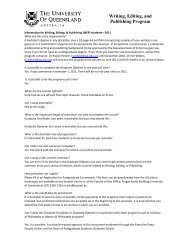Australian Women's Book Review Volume 14.1 - School of English ...
Australian Women's Book Review Volume 14.1 - School of English ...
Australian Women's Book Review Volume 14.1 - School of English ...
You also want an ePaper? Increase the reach of your titles
YUMPU automatically turns print PDFs into web optimized ePapers that Google loves.
The Hallmark <strong>of</strong> the Ordinary<br />
Anita Diamant, Good Harbour. Allen and Unwin, 2001<br />
<strong>Review</strong>ed by Carolyn Hughes.<br />
Reading this book was a depressing experience. Not because <strong>of</strong> the subject matter <strong>of</strong> mid-life marital<br />
trouble and breast cancer, but because these themes are handled without any depth or even sharp<br />
observation. The novel is riddled with clichés at every turn - the plot, the characters, the dialogue, the<br />
setting, the ending.<br />
The main characters, Kathleen and Joyce, meet in a seaside town at a difficult time in their lives. They<br />
form a friendship that exceeds the limits <strong>of</strong> the closeness they have with their husbands. On their<br />
regular walks together along the beach at Good Harbour they share secrets and talk about parts <strong>of</strong> their<br />
lives they feel they can't discuss within their respective marriages. The title <strong>of</strong> the novel and the name<br />
<strong>of</strong> the beach, Good Harbour, are not very subtle hints at the role <strong>of</strong> the friendship as a good harbour<br />
during life's troubles.<br />
Kathleen doesn't relate to her husband Buddy as easily as she does to other women, and strongly feels<br />
the absence <strong>of</strong> her sister, who died years previously from breast cancer. Kathleen is a children's<br />
librarian and, like her sister, is diagnosed with breast cancer; hers, however, is a lesser form that is<br />
successfully treated with surgery and radium therapy.<br />
Joyce is writing a romance novel at a cottage near Good Harbour and the novel is faltering, along with<br />
her domestic arrangements. As a reaction to her increasingly distant marriage she has an affair with an<br />
inexplicable character who won't take his pants <strong>of</strong>f, for reasons that remain unknown. She is depressed<br />
because, in her own words she is 'such a cliché'. If a character in the text can articulate these words,<br />
why then doesn't Diamant go deeper than the cliché? Why not explore the nuances <strong>of</strong> Joyce's<br />
ordinariness? Or examine why the character considers herself to be a cliché? The novel is like a long<br />
Hallmark card and, funnily enough, Joyce says to Kathleen: 'I love it up here. But when I try to explain<br />
what made me pick Gloucester, I end up sounding like a Hallmark card.' This is an unfortunate choice<br />
<strong>of</strong> words for Joyce because it can ironically be applied both to the character's life and the novel in<br />
general.<br />
Each character speaks <strong>of</strong> problems with motherhood - and this is where the novel has its few interesting<br />
if undeveloped moments. Kathleen's grown sons could have provided more complexity, particularly in<br />
regard to Jewishness and the relationship between mother and son. Joyce's twelve year old daughter is<br />
shuffled <strong>of</strong>f to camp and out <strong>of</strong> the novel making her presence brief, although she does provide some<br />
interesting tension.<br />
Because <strong>of</strong> the flatness and clichés, there is no sparkle. Good Harbour <strong>of</strong>fers nothing significant in<br />
terms <strong>of</strong> a literary contribution to representations <strong>of</strong> female friendship. The friendship is ultimately<br />
unconvincing because it is dialogue-driven with little inner narrative. The dialogue between the two<br />
women tries really hard to be fresh and witty, but comes across as a bit flirty and strained (Gilmore<br />
Girls-esque), and doesn't convey any ease or familiarity between the two women.<br />
I imagine the audience Diamant attracted with The Red Tent would have had, like myself, higher<br />
expectations <strong>of</strong> her second novel. Without the setting and characters already sketched for her (The Red<br />
52








